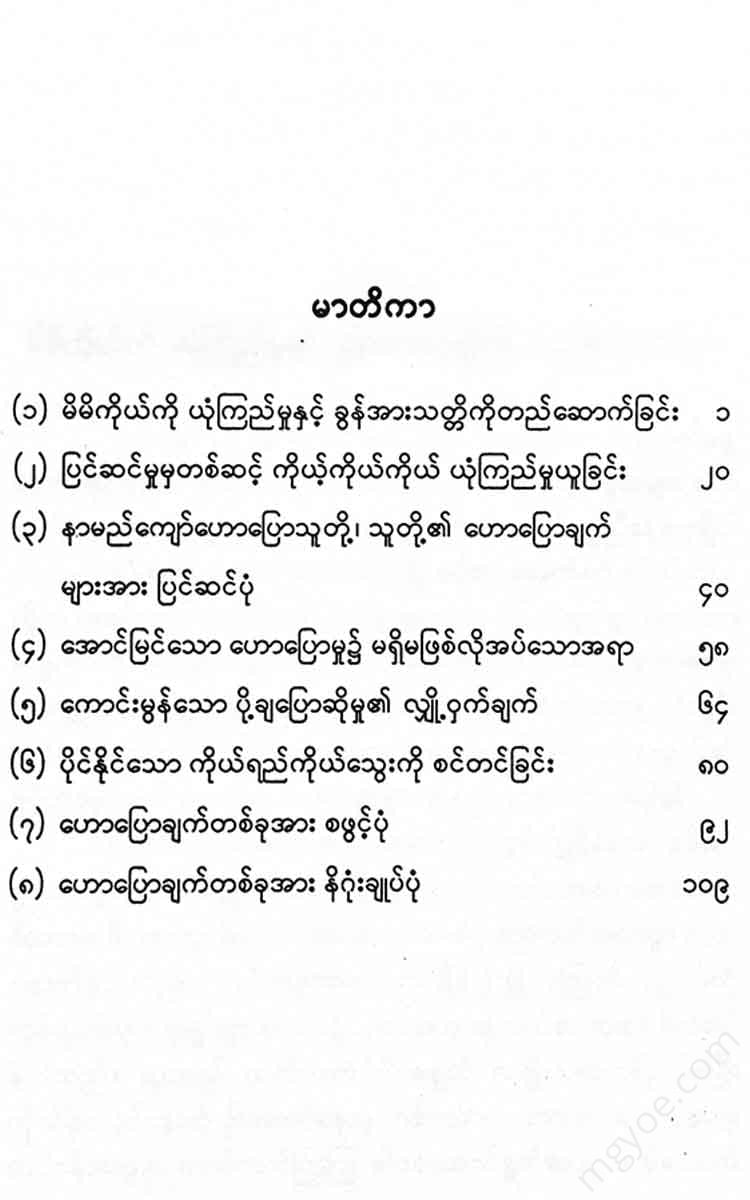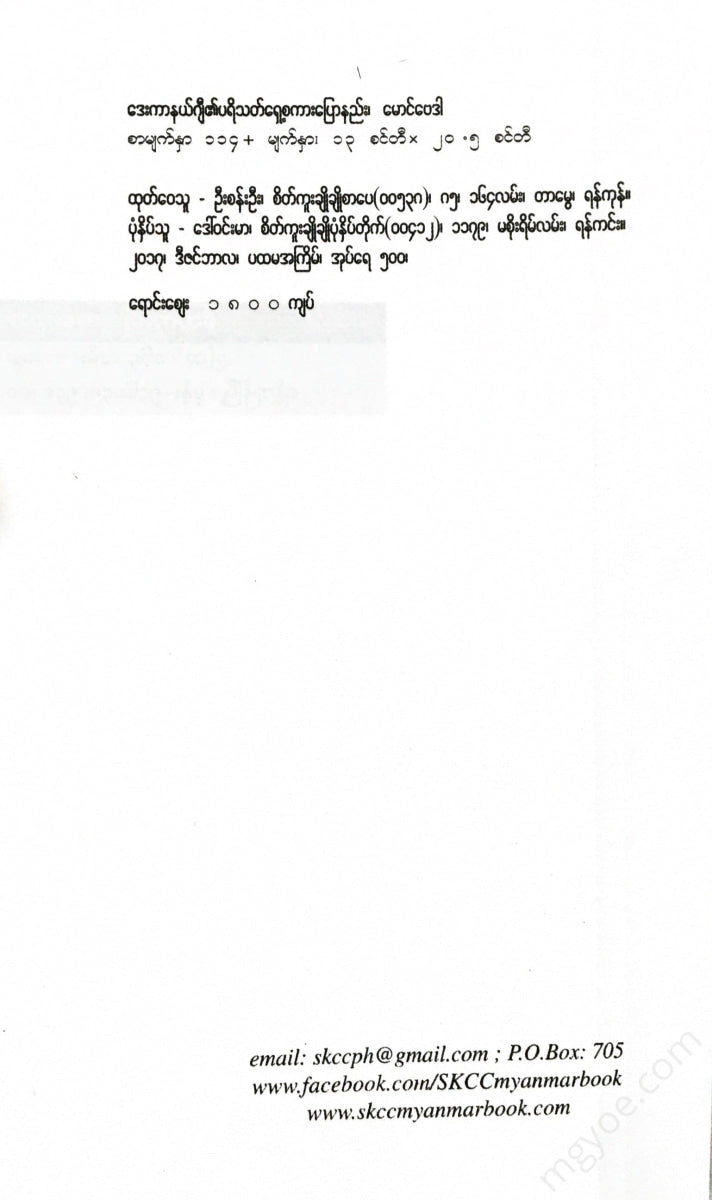စိတ်ကူးချိုချိုစာပေ
Maung Beda - Dale Carnegie's method of public speaking
Maung Beda - Dale Carnegie's method of public speaking
Couldn't load pickup availability
Part (1)
Building self-confidence and strength
The statements that many people who enroll in my public speaking courses often have are surprisingly similar. “I’m very cautious and nervous when I get on stage to speak. I forget what I’m going to say and can’t concentrate. I want to be able to speak in front of people with confidence and clarity.” Thousands of their confessions are similar.
To illustrate more clearly, several years ago a gentleman named Mr. D. W. Young attended my public speaking course in Philadelphia. Shortly after the first part of the course, I was invited to lunch with him at the Manufacturers Association. He was a middle-aged man, self-employed, and active in religious and social activities. As we were eating lunch that day, he leaned over the table and said:
“ I have often been asked to speak at gatherings. But I have never been able to do so. I have been so emotional that I have become speechless. That is why I have always avoided speaking. But now I am the chairman of a college board. I have to preside over the meetings. I have to speak anyway. Do you think I will be able to speak at this age?”
" My opinion, Mr. Gent," I replied. "This is not a matter of questioning my opinion. I know you can do it. And I know you will if you follow the instructions."
He wanted to believe me, but he seemed to think my words were meant to be encouraging and positive. “You’re just trying to cheer me up.”
After the training, we briefly lost touch. Later, we met again at lunch at the Manufacturers Association. We had sat at the same table as the first time we met. Recalling our previous conversation, I asked him if I had had too many expectations of him at the time. He took a small red notebook from his pocket and showed me a list of lectures and dates he had pinned. “The ability to do this, the satisfaction I get from doing it, the extra service I can provide to the organization, these are among the things I am most grateful for in my life,” he said.
A few days before, an important disarmament conference had been held in Washington. When it was learned that the British Prime Minister was to attend the event, the Philadelphia Baptist Church sent me a telegram inviting me to speak at a grand religious festival to be held in their city. Mr. Gent informed me that he had been chosen from among all the Baptists in the city to introduce the British Prime Minister to the audience.
This is the same person who sat at the same table three years ago and seriously questioned my opinion on whether he could speak in front of an audience.
Is his rapid increase in speech unusual? Not at all. There are hundreds of cases like this, and hundreds of others like it. To give another example, a Brooklyn physician named Dr. Curtis was staying near the Giants baseball team’s training grounds in Florida. He was a big baseball fan and often went to watch the players practice. Over time, he became quite familiar with the team. He was invited to a dinner party for the players.
After the food was served, and a few words were spoken to the distinguished guests, he suddenly and unexpectedly heard an announcement from the master of ceremonies.
"We have a physician with us tonight. Let's invite Dr. Kartik to say a few words about the health of athletes."
Was he prepared? Of course he was. He had the best preparation in the world. He had been studying personal and environmental hygiene for a third of a century, and he had been practicing medicine for a third of a century. If he had to speak on this subject from the chair he was sitting in, to the people on either side of him, he could speak like a thunderbolt. But standing up and speaking to a small audience was a different matter. It was a matter of hesitation. His heart was beating wildly. He had never spoken before in public in his life. The thoughts he had were now scattered and scattered. (What should he do? The audience was clapping. Everyone was looking at him. He shook his head. But that only made the applause he had been demanding louder. The cheers of "Dr. Carta, say something. Dr. Carta, say something" got louder and louder.
He was really struggling. He knew that if he spoke, he would not be able to say ten straight words. He was so embarrassed that he did not say a word, but he got up from his seat, turned his back on his friends, and quietly left the room.
One of the first things he did when he got back to Brooklyn was sign up for my “Public Speaking” class. He didn’t want to be embarrassed a second time.
He is the type of student who is always ready to teach. He is also very eager. He wants to speak well. He is not at all hesitant about his desire. He prepares his words carefully. He practices enthusiastically. He never misses a single moment of the training.
He followed everything a trainee would do. He improved at a rate that even surprised himself, exceeding his wildest expectations. After the first few sessions, his anxiety diminished. His confidence soared. Within two months, he had become a prominent speaker in his group. Soon he was accepting invitations to speak in other venues as well. Now he was enjoying the thrill of public speaking, the unique exposure, and the widening circle of friends that came with it.
A member of the New York City Republican Party campaign committee heard one of his speeches and invited Dr. Carty to tour the city to canvass for his party. The speaker for him had just been embarrassed at a dinner party the previous year, terrified of the crowd.
Introduction
De Kanalji's name has been associated with the book 'How to Win Friends and Influence People' for many years. The book became a best-seller in the online literature and made him internationally famous. However, ' How to Win Friends and Influence People' is not De Kanalji's first book.
In 1926, DeCarnegie wrote a book called 'Public Speaking and Influencing Men in Business'. This book is a classic on public speaking and to this day is one of the official textbooks of the world-famous DeCarnegie course on effective public speaking and interpersonal communication. It is also the textbook for the YMBA speaking club. The book has sold millions of copies and has been translated into about 20 languages and published in foreign countries. However, it has not been widely recognized by the general public.
Recently, a publisher at the Press Association suggested that my ex-husband's earlier books be republished. They felt, as I did, that the book contained many valuable ideas for everyday living. The Deka Nelji course has now spread its ideas around the world and has produced many graduates. The course helps people discover their inherent strengths and live stronger, happier, and more fulfilling lives.
This book contains many wise words that have helped our students achieve success. After carefully reviewing the book before publishing it, I realized how many insightful rules it contains for overcoming fear and gaining self-confidence. It also includes practical tips and advice that will help everyone communicate effectively, whether one-on-one or in groups.
I hope that readers and fans can learn as much as the Deka Nelji students through this book.
Dorothy Carnegie
table of Contents
( 1) Building self-confidence and courage 1 (2) Gaining self-confidence through preparation 20 (3) Famous speakers and their speeches
How to prepare for a speech (4) Essentials of a successful speech (5) Secrets of good delivery (6) Developing a positive personality (7) How to start a speech (8) How to conclude a speech
Share











